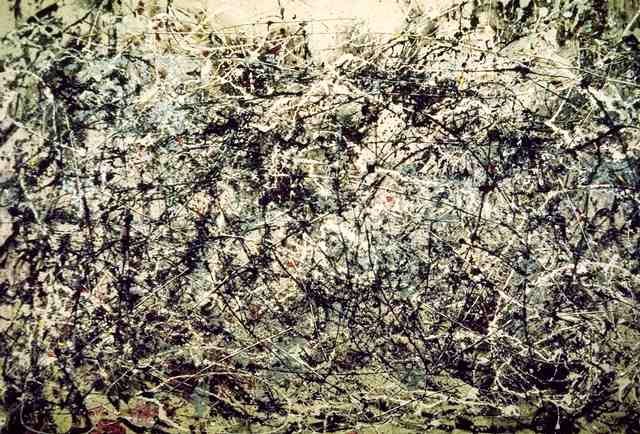The way I first heard it was a rumor, a bit of gossip. This is how the story went – The main art critic of the time, Clement Greenberg, was gay, arch, and powerful while Jackson was rebellious, macho and a drunk – and they hated each other. So when Jackson heard Clement was coming to see his work, he was so pissed at being judged by this man, he just threw some paint drips all over a canvas and showed it to him. Clement knew he was being insulted, so he turned it around on poor Jackson by saying “Fabulous, you will paint this the rest of your life.” True to his word he made the drip paintings famous and Jackson had to paint them for the rest of his life, a fate worse that death for a man so talented at image making. I was impressed with this story and thought it should be a play, especially after I was so thoroughly bored by the Hollywood version of Pollock’s life.
Now I suspect this tale is a lie, but in every lie there is a kernel of truth, so what was going on? Some think Pollock’s art is an important piece in the dialogue between the object and the method, which started with the impressionists and ended with the Campbell’s soup can – this is a rarified discussion that is held among artists but only impresses us when their talent is so great that their art surpasses any kind of dialogue, like Picasso and Cubism.
Others believe it was a shrewd move by Greenberg to declare Pollock’s work a new style of painting, Abstract Expressionism, which moved the art scene from Europe to New York. An added plus was that if there is no recognizable image, a confused audience depended more on the powerful critic to tell them which of these new paintings are good or bad. This of course makes the art market more controlled and therefore a more secure place for people to dump money and be assured of a profitable resale.
Greenberg’s theory behind this new art was that the art was purer without the old-fashioned hang-ups of story, figure, landscape perspective. My theory is for real purity : Why not leave the paint in the tube. Seriously, doesn’t getting rid of the body and leaving just the expression sound like that old-fashioned religious idea of heaven where you’re free of the flesh but on the other hand you don’t matter anymore because you’re dead. Jackson was so macho, he reduced the brush stroke to a hand job and paint to endless dribbles of semen filling gigantic canvasses – truly a man’s wet dream.
As for the gullible public, I think we were so thirsty for change, so impressed with our modern ideas of progress, so positive that our new democracy would be the inventors of this change, that we were ready to love anything. Odd that individualism would entail getting rid of the figure and that we should be interested in how the artist felt rather than what he made. We are left with a Rorschach test rather than a painting and a tremendously talented artist forced to abandon his talent. Why kill the image? What did it ever do but bring us pleasure – is pleasure so bad? But people fell for this golden calf because they were seduced by Jackson’s charisma. He was a star and that’s what America really worships.
Artillery Magazine Vol 4 no. 4 March/April 2010

While I don’t agree with you on Pollock – I do quite like some of his work – I still enjoyed your take on him, especially the once-your-read-it-you-can’t-forget-it analogy of his turning the act of painting into a hand job and his flinging of paint into ejaculations. I do prefer Bacon over Pollock though, buy a long margin.